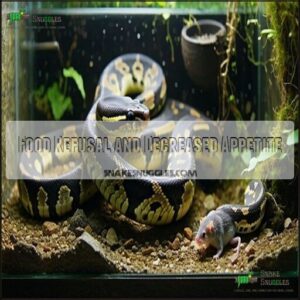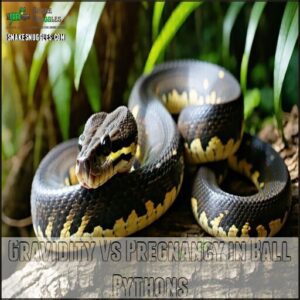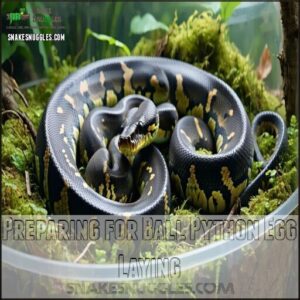This site is supported by our readers. We may earn a commission, at no cost to you, if you purchase through links.

Look for a thicker midsection and visible lumps when she curls up—these can signal the presence of developing eggs.
She may refuse food, soak in her water bowl more often, or even flip onto her back to stretch.
Some females "glow," showing brighter scales, and their appetite often drops after ovulation.
Palpating her belly gently can help confirm lumps, but an X-ray or ultrasound gives the clearest answer.
Understanding these signs helps you prepare for her needs as she approaches egg-laying. She may refuse food, thicker midsection, and visible lumps.
Table Of Contents
- Key Takeaways
- Identifying Gravid Ball Pythons
- Signs of a Gravid Ball Python
- Ball Python Breeding Requirements
- What is Ovulation in Ball Pythons?
- Caring for a Gravid Ball Python
- Gravidity Vs Pregnancy in Ball Pythons
- Preparing for Ball Python Egg Laying
- Ball Python Gestation Period and Egg Incubation
- Post-Laying Care for Ball Pythons
- Confirming Gravidity and Avoiding False Identification
- Frequently Asked Questions (FAQs)
- How can you tell if a ball python is pregnant?
- Is my ball python gravid pregnant?
- What does it mean if a ball python is pregnant?
- Do gravid ball pythons lay eggs?
- How do ball pythons get pregnant?
- What color does a gravid ball python change to?
- How long is a ball python gravid for?
- How to tell if your ball python is going to lay eggs?
- What is a gravid female snake?
- Can I let my ball python incubate her own eggs?
- Conclusion
Key Takeaways
- Watch for physical signs like a lumpy midsection, swollen abdomen, and glowing or stretched skin.
- Look for behavioral changes like food refusal, cool-seeking, soaking in the water bowl, or nesting behaviors.
- Confirm gravidity by gently palpating for lumps or consulting a vet for an ultrasound.
- Maintain ideal conditions with proper temperature, humidity, and minimal stress to support her and her eggs.
Identifying Gravid Ball Pythons
You can spot a gravid ball python by watching for changes in her body and behavior.
Recognizing these signs early helps confirm you’re providing the right care during this critical stage.
Physical Signs and Changes
If your ball python is gravid, physical signs are your first clue.
Watch for changes such as:
- Lumpy appearance from growing follicles
- Swollen abdomen, especially near ovulation
- Skin changes, like brightening or glowing scales
- Posture shifts to accommodate eggs
- Scale visibility due to stretching
These python pregnancy signs clearly indicate a gravid ball python.
Behavioral Patterns and Changes
A gravid ball python’s behavior shifts noticeably during pregnancy.
You’ll observe distinct activity shifts, including cool-seeking behavior where she avoids heat sources and may wrap around her water bowl to regulate egg temperature.
Appetite changes become apparent as she often refuses food entirely.
Watch for increased aggression levels, especially during ovulation, when handling should be minimized.
Nesting preparation emerges as she searches for safe egg-laying spots.
Snake gravid signs also include restlessness, frequent position changes, and inverted basking (lying belly-up).
These behavioral changes, combined with physical indicators, provide clear ball python pregnancy signs that help you provide appropriate care during this sensitive time.
Importance of Accurate Identification
While behavioral shifts reveal much about your female ball python‘s condition, correctly identifying gravidity is important for their wellbeing.
Accurately spotting visual signs of a gravid ball python prevents health complications and unnecessary stress.
Track physical changes, appetite fluctuations, and temperature-seeking behaviors methodically.
When in doubt, consult a reptile veterinarian—your snake’s health depends on proper care. Accurate identification is the foundation of breeding success and ethical husbandry practices.
Signs of a Gravid Ball Python
You’ll notice several key physical and behavioral changes when your female ball python becomes gravid.
Her abdomen will swell and develop a lumpy appearance, and she’ll likely seek cooler areas of the enclosure while showing a decreased interest in food.
Sudden Swelling of The Abdomen
When your female ball python becomes gravid, a sudden abdominal swelling will be one of the first visual signs you’ll notice.
- Abdominal distension occurs approximately 84 days after breeding
- Ovulation swelling causes the middle section to expand dramatically
- Post-ovulation size remains larger than normal for several weeks
- Swelling duration typically lasts throughout the gravid period
- Unlike mimicking swelling from meals, this expansion appears uniform.
Gravid females may also exhibit frequent basking behavior.
Lumpy Appearance and Weight Gain
After the initial abdominal swelling, you’ll notice your gravid ball python "lumping up" with a distinctive marble-like texture.
This follicle development creates visible lumps about two-thirds down the body, indicating egg formation.
Weight gain becomes evident as your snake’s mid-body thickening progresses.
You may observe scale changes where skin becomes visible between scales and posture shifts as she accommodates the developing eggs.
When gently palpating your ball python, you’ll feel firm, round masses larger than quarters.
The swollen abdomen creates a wider, bulging appearance with a characteristic V-shape along her back. Marble-like texture.
Food Refusal and Decreased Appetite
Many gravid ball pythons completely refuse food during their pregnancy cycle.
This appetite change is a key indicator of gravidity stages that distinguishes normal feeding patterns from pregnancy-related behavior.
- Your usually voracious eater might suddenly turn her nose up at her favorite rat
- That perfect feeding record may come to a screeching halt without warning
- The food refusal period can last throughout the entire gravidity process
Remember to monitor weight and hydration levels despite reduced feeding.
Offer smaller meal sizes occasionally, but don’t worry if she refuses—it’s perfectly normal during this time.
Aggressive Behavior During Ovulation
During ovulation, your normally docile ball python may display aggressive behavior due to hormonal changes.
You’ll notice:
- Sudden striking or biting when approached
- Increased defensive posturing with tightened coils
- Frequent musk release as a warning signal
- Temperament shifts including tail rattling
- Enclosure aggression when you’re nearby
This behavior is temporary. Reduce handling to minimize stress and maintain distance until the ovulation period passes.
Ball Python Breeding Requirements
You’ll need to meet specific requirements before your female ball python can become gravid, including a minimum weight of 1,500 grams and age of at least two years.
Successful breeding also depends on proper environmental conditions like temperature cycling and humidity levels that mimic the snake’s natural habitat.
Age and Weight Requirements for Gravidity
Before your female ball python can become gravid, she must meet specific requirements:
- Minimum Age: Must be at least 2 years old
- Weight Thresholds: Should weigh over 1,500 grams (3.3 lbs)
- Physical Condition: Needs good muscle tone and body condition
- Health Status: Should be free of parasites and respiratory issues
Breeding season timing is critical.
Attempting to breed underweight or young snakes can lead to serious health complications.
Mating and Fertilization Process
Once your female ball python has reached proper size and age, understanding the mating process is your next step.
During mating, males and females intertwine their tails in a position called "tail locking" that can last up to 24 hours. This allows sperm transfer to occur.
Remarkably, ball pythons have sperm retention abilities, meaning fertilization can happen weeks or even years after mating.
If fertilization doesn’t occur, females can reabsorb their follicles.
Parthenogenesis (reproduction without mating) is extremely rare.
Environmental Triggers for Mating Behavior
Now that you understand fertilization, creating the right environment is your next step for successful breeding.
Ball pythons respond to specific environmental triggers that simulate their natural habitat’s seasonal changes.
To encourage mating behavior in your pythons:
- Lower temperatures gradually (75-80°F during day, 70-75°F at night) to mimic the approach of breeding season
- Reduce lighting duration to 10-12 hours daily, signaling seasonal changes
- Increase humidity levels to 60-70% to support reproductive health
These environmental adjustments work together to activate your ball python’s breeding instincts.
To guarantee success, prioritize healthy adult selection.
Barometric pressure changes may also play a role, though they’re harder to control in captivity.
Temperature regulation remains the most reliable trigger, convincing your pythons it’s time to mate.
What is Ovulation in Ball Pythons?
You’ll notice ovulation in your female ball python when her abdomen suddenly swells and becomes firm, a critical stage in the reproductive process.
During this phase, her follicles dramatically increase in size, causing visible lumps about two-thirds down her body and often accompanied by a distinctive brightness to her scales known as a "pregnancy glow.
Identifying Ovulation Through Physical Signs
When your ball python ovulates, you’ll notice abdominal swelling and a lumpy appearance along her midsection.
Her skin changes, becoming brighter with a subtle pregnancy glow, and scale visibility increases as the body stretches.
These signs, paired with posture shifts, make ovulation distinct.
To help, here’s a quick table:
| Sign | Description | Location |
|---|---|---|
| Abdominal Swelling | Intense, localized swelling | Mid-body |
| Lumpy Appearance | Raised, visible lumps | Posterior body third |
| Skin Changes | Brighter, looser skin | Overall |
| Scale Visibility | Gaps between stretched scales | Across the abdomen |
Spotting lumping up and follicles?
That’s your python entering this critical phase of potential gravidity.
Post-Ovulation Behavior and Changes
After ovulation, a gravid ball python’s behavior shifts. Look for these signs:
- Cool-seeking behavior: She’ll avoid heat sources or lie inverted.
- Appetite changes: Eating less or outright refusing food.
- Restlessness increases: Frequent pacing or constant position shifting.
- Rebuffing males: Strong reluctance to mate again.
- Nesting preparation: Hiding or rearranging substrate in her enclosure.
Females often exhibit tighter coiling behavior during this period.
Importance of Ovulation in Gravidity
After ovulation, your female ball python’s follicles grow, marking the fertilization window and enabling gravidity onset.
Tracking ovulation signs guarantees reproductive success and supports you in adjusting care.
Here’s why it matters:
- Times fertilization accurately.
- Boosts egg health via follicle development.
- Guides care adjustments for gravid ball pythons.
- Enhances hormonal balance.
- Prepares for the pre-lay shed.
Caring for a Gravid Ball Python
Caring for a gravid ball python means creating a stress-free environment, maintaining humidity, and providing warmth for healthy egg development.
Caring for a gravid ball python means adjusting their environment to support proper egg development.
You’ll need to maintain ideal temperatures, monitor humidity, and minimize stress to keep her healthy.
Temperature and Humidity Control
Creating the right environment is like fine-tuning a recipe for your gravid ball python’s comfort and health.
Temperature control is the first ingredient. Set up a gradient: 88-92°F on the warm side and 80-84°F on the cool side. Keep ambient temperatures between 75-80°F. A dependable thermostat makes certain no sudden spikes or drops, safeguarding her well-being. To maintain these temperatures, consider using a quality thermostat product.
Humidity levels play a key role too. Aim for 60-70% with reliable humidity management tools like a hygrometer.
As egg-laying approaches, raise it to 80-90% to support shedding success and proper incubation conditions. Balance moisture and airflow to prevent mold.
Track everything consistently with multiple thermometers and hygrometers for accuracy. Seasonal adjustments to environmental conditions can work wonders.
- Pro Tip: Arrange heat sources so she can choose ideal gradients. Watch her behavior—it often reflects whether adjustments are needed.
Feeding Requirements and Adjustments
During gravidity, your ball python’s feeding habits shift dramatically, so paying attention is key.
Appetite changes are common—many gravid snakes eat less or completely refuse food.
Here are practical ways to adjust her diet:
- Feeding Frequency: Offer smaller prey once every 10-14 days.
- Prey Size: Choose prey pieces no larger than 1.5 times her mid-body width.
- Supplementation Needs: Dust prey with calcium powder to support egg development.
To help proper egg development, consider ball python supplements.
- Hydration Importance: Supply a constant supply of fresh water.
- Weight Monitoring: Track her weight weekly to maintain consistent health.
If she shows interest in food, provide manageable meals.
Food refusal is normal, but keeping her hydrated and monitoring her condition guarantees a healthy gravid ball python.
Providing a Safe and Stress-Free Environment
To keep your gravid ball python comfortable, prioritize Enclosure Security by providing multiple hide boxes where she can explore both warm and cool spots.
Guarantee a proper Temperature Gradient of 88-92°F and maintain Humidity Levels at 60-70%.
Limit handling; gentle Handling Techniques are best only when necessary.
Watch for pregnancy signs, like nesting behavior, and consider adding a nesting box for extra comfort.
Stable temperature regulation and minimal stress support egg development, promoting healthier ball python behavior during this critical period.
Gravidity Vs Pregnancy in Ball Pythons
Gravidity and pregnancy might seem like interchangeable terms, but in ball pythons, they mean different things.
Understanding these differences helps you accurately identify your python’s reproductive stage and provide proper care.
Differences Between Gravidity and Pregnancy
It’s common to mix up gravidity and pregnancy, but they’re quite different.
Gravidity in reptiles, like your gravid ball python, involves carrying developing eggs, while pregnancy refers to mammals carrying live embryos.
These physiological differences stem from distinct reproductive processes.
Here’s a quick comparison:
| Aspect | Gravid Ball Python | Pregnant Mammals |
|---|---|---|
| Egg Development | External, after laying | Internal, until birth |
| Visual Signs Gravid | Lumpy abdomen, "pasta belly" | Progressive belly swelling |
| Parental Investment | Protective egg-laying | Nourishing fetuses internally |
Understanding reptile terminology and evolutionary context makes sure you’re prepared to meet your python’s needs.
Common Misconceptions and Myths
Mistaking a gravid ball python for one that’s just overweight or sick is surprisingly common.
Misconceptions like “Sperm Storage Myths” and “Parthenogenesis Likelihood” often cloud reality.
Females can store sperm, but false gravidity or infertile eggs are more frequent.
A gravid ball python doesn’t always glow—changes in skin brightness may stem from regular shedding.
Similarly, weight gain isn’t always linked to pregnancy; constipation or overeating also cause bulk.
Here’s a breakdown of common myths:
| Misconception | Reality |
|---|---|
| Shedding = Pregnancy | Shedding isn’t exclusive to gravidity. |
| Weight = Pregnancy | Overeating mimics pregnancy signs. |
| Guaranteed Fertility | Eggs are often infertile. |
| Parthenogenesis is Common | Rare cases, not the rule. |
| Palpation Guarantees Accuracy | Inexperience leads to false results. |
Importance of Accurate Understanding
Understanding the difference between a gravid ball python and one showing pregnancy signs helps you avoid missteps that could harm your snake.
Misinterpreting swollen abdomens or changes in ball python behavior can lead to serious health implications.
For breeding success and responsible ownership, focus on clear observations.
| Observation | Gravid Sign | Misinterpretation |
|---|---|---|
| Swollen abdomen | Developing eggs | Obesity or impaction |
| Food refusal | Normal gravid behavior | Illness or stress |
| Cool-seeking habits | Caring for eggs | Poor enclosure conditions |
Monitoring real signs makes possible ethical care, conservation efforts, and a healthy reptile.
Preparing for Ball Python Egg Laying
Preparing for your ball python’s egg-laying is vital to guarantee her health and the safety of her clutch.
You’ll need to provide a secure environment, monitor her nesting behaviors, and adjust feeding and hydration to meet her needs.
Creating a Suitable Environment
A gravid ball python needs the right environment to stay healthy and prepare for egg-laying. Proper temperature control and humidity levels are key to supporting her.
Aim for consistent temperature gradients of 88-92°F on the warm side and 60-70% humidity across the enclosure.
A cozy nesting box—filled with damp sphagnum moss—gives her a safe place to lay eggs.
The enclosure should also be spacious and include secure hiding spots for comfort and stress reduction. Choose a soft substrate, like cypress mulch, to mimic her natural habitat. For peak health, consider PVC enclosures which offer superior moisture resistance.
- Ideal temperature gradients: 88-92°F
- Humidity levels: 60-70%
- Soft substrate, like cypress mulch
- Spacious enclosure with hiding spots
- Nesting box with damp moss
Nesting Behaviors and Preferences
After the prelay shed, a gravid ball python’s nesting behavior becomes obvious.
She may push bedding into depressions or repeatedly rearrange her nesting site.
Guarantee her nesting environment feels secure by using a dark nest box with damp substrate, maintaining 65-70% humidity levels.
Include a warm side at 90°F to balance temperature gradients.
- Keep her nest box private to reduce stress.
- Offer nesting materials like shredded coconut husk or newspaper.
- Watch for her preferring cooler areas of the enclosure.
- Guarantee substrate choice stays slightly damp but not soggy.
- Guarantee her security needs remain met continuously.
Adjusting Feeding and Watering Schedules
Your female ball python’s changing appetite during gravidity is completely normal and signals key adjustments are needed.
As she nears egg-laying, appetite changes often lead her to refuse food. Offer smaller prey every 10-14 days and don’t stress if she skips meals—her energy focus is elsewhere.
Hydration is critical for a gravid ball python’s health and egg development.
Keep her water bowl spotless, consistently filled, and large enough for soaking.
Recognizing dehydration—dull skin, wrinkling, or lethargy—is key during this stage.
Feeding adjustments should focus on maintaining her weight without overfeeding.
Avoid forcing meals; instead, monitor her progress closely.
While appetite stimulants or supplementation needs are rare, prioritize fresh water and carefully balanced feeding to support her during this delicate time. Appetite changes often lead her to refuse food, so offer smaller prey.
Ball Python Gestation Period and Egg Incubation
Understanding the gestation period and incubation process is key to ensuring healthy eggs and hatchlings. You’ll need to monitor timeframes carefully and provide proper environmental conditions throughout.
Average Gestation Period and Egg Laying
How long does it take from ovulation to the big moment?
Ball python eggs are typically laid 44-50 days after ovulation.
Clutch sizes vary, with most pythons producing 4-8 eggs, but some might surprise you with as many as 13.
Infertile eggs, or “slugs,” are easy to spot thanks to their yellowish color and tapered shape.
Once eggs are laid, the gestation phase ends, shifting into the incubation timeline.
Incubation Process and Requirements
Maintaining healthy python eggs starts with proper egg incubation techniques.
Success depends on four critical factors:
- Incubation Temperatures: Keep temperatures steady at 88-90°F to make certain embryo development.
- Humidity Levels: Maintain 85-95% to prevent eggs from drying out.
- Substrate Types: Use a vermiculite-perlite mix for stable moisture.
- Egg Candling: Monitor growth without handling eggs directly.
A reliable egg incubator system is key. Many breeders utilize a python egg incubator for consistent results.
Minimize disruption and check conditions regularly to avoid hatching problems, guaranteeing a smooth incubation process.
Hatching and Post-Hatching Care
When those tiny heads start poking through the shells, it’s time to focus on posthatching care.
Keep the hatchling enclosure at 88-90°F with humidity around 70-80% to support their development.
After egg incubation, hatchlings will shed for the first time within a week or so—this marks when you should begin offering small meals. Some may take longer to eat; don’t stress, just be patient.
Monitor their growth, hydration needs, and overall health. Regular health monitoring makes certain no issues go unnoticed.
A steady environment and simple feeding strategies help these hatchlings thrive after such careful egg development and care.
Post-Laying Care for Ball Pythons
After your ball python lays her eggs, she’ll need your support to recover and regain strength. Proper care includes monitoring her health, ensuring hydration, and offering small, manageable meals.
Maternal Recovery and Care
Your ball python needs gentle attention during her post-lay recovery. Focus on her hydration and nutrition to aid healing and regain strength.
Offer smaller, frequent meals during post-lay feeding to avoid overwhelming her.
Clean the enclosure to maintain hygiene and reduce stress. Confirm the humidity stays between 60-70% to support shedding and overall health.
- Provide fresh water daily to meet her hydration needs.
- Keep the environment calm and quiet for stress reduction.
- Watch for her post-lay shed as a progress sign.
- Resume handling only after her recovery time is complete.
Egg Incubation and Hatching
Egg incubation is essential for your python’s breeding success, requiring close attention to details like incubation temperatures and humidity levels.
Aim to maintain a steady 88°F (31°C) with humidity levels near 90%. These settings guarantee proper egg development and prevent dehydration, which can jeopardize egg viability.
Use a reliable thermostat and hygrometer to monitor the environment, correcting any shifts quickly.
Check the eggs weekly for dimpling or discoloration, as these can signal potential hatching problems. Egg candling can help confirm egg fertility by showing vein development inside.
The incubation process usually lasts 55-60 days. Keep conditions stable throughout—sudden fluctuations can harm embryos.
Remember, stable temperatures and humidity create the best environment for healthy, stress-free egg hatching.
Post-Hatching Care and Monitoring
After egg hatching, hatchling care is your next priority.
Baby pythons typically shed 7-10 days after emerging. Here’s what to focus on for healthy neonates:
- Feeding Schedule: Offer pinky mice after their first shed.
- Hatchling Enclosure: Set individual spaces with 88-90°F hot spots and 60% humidity to support hydration needs.
- Health Monitoring: Keep an eye on shedding and appetite for signs of growth.
Postlay care guarantees smooth progress.
Confirming Gravidity and Avoiding False Identification
Confirming your ball python’s gravidity confirms you’re not confusing normal changes with false signs.
Using palpation or an ultrasound provides accurate results, helping you avoid misinterpreting her behavior or physical appearance.
This approach ensures that you can distinguish between actual signs of gravidity and false signs.
Palpation and Ultrasound Techniques
When checking pregnancy signs in a gravid ball python, palpation accuracy depends on experience.
Gently run your fingers along her abdomen to feel for developing follicles, but this requires skill to avoid harming her.
Ultrasound offers clearer confirmation but comes with limitations like imaging costs.
Early detection works best with an experienced vet who can guarantee safe palpating. Veterinarian confirmation prevents misidentification, guaranteeing accurate pregnancy checks while protecting your python.
Recognizing False Gravidity and Pseudopregnancy
Sometimes, a female snake may mimic pregnancy without being truly gravid. This condition, called pseudopregnancy or false gravidity, can resemble actual ball python pregnancy but misses key patterns like consistent weight gain or prepared nesting.
- Irregular weight gain from conditions like Constipation Mimicry or Overweight Confusion.
- Behavioral shifts fading quickly, unlike true gravid ball python patterns.
- No visible follicles, which could mean Reabsorbed Follicles or Imaging Limitations.
Still unsure? A vet can confirm through tests like ultrasound.
Importance of Accurate Confirmation
Knowing if your ball python is actually gravid confirms you’re prepared without unnecessary stress or expenses. Misdiagnosis can mean wasted resources and missed health issues. Accurate confirmation helps care and reduce stress for both you and your snake. Look for reliable signs, but don’t rely solely on visual changes like a swollen abdomen or the "pregnancy glow."
Consider these proven methods:
- Ultrasound scans: The clear go-to for confirming gravid ball pythons.
- Palpation by a vet: A trained touch can detect developing eggs.
- Monitor pre-lay shed timing: This occurs two to three weeks before laying eggs.
- Track weight gain: Gradual, consistent gains often confirm pregnancy.
- Notice behavior changes: Cool-seeking or nesting behaviors help validate observations.
Taking preventative measures avoids costly mistakes.
Frequently Asked Questions (FAQs)
How can you tell if a ball python is pregnant?
Did you know gravid ball pythons can carry up to 13 eggs?
Look for a lumpy mid-body, vibrant skin, and swollen abdomen.
Cool-seeking behavior and decreased appetite are also big signs she’s expecting.
Is my ball python gravid pregnant?
Look for signs like a lumpy midsection, glowing skin, or cool-seeking behavior.
She might refuse food, soak in her water bowl, or show aggression.
These combined are strong clues she’s gravid.
What does it mean if a ball python is pregnant?
When your ball python is pregnant, she’s carrying eggs inside her body.
This period, called gravidity, brings physical changes like a swollen, lumpy abdomen and behavioral shifts like cool-seeking, restlessness, or refusing food.
Do gravid ball pythons lay eggs?
When nature whispers its secrets, your gravid ball python will lay eggs around 30 days after her pre-lay shed. Expect 1–13 eggs per clutch, with fertile ones hatching after about 55–60 days.
How do ball pythons get pregnant?
Female ball pythons get pregnant through mating, where a male entwines tails to fertilize her eggs.
Sperm can be stored for years, enabling delayed fertilization.
Proper environmental cues, like temperature changes, trigger successful breeding.
What color does a gravid ball python change to?
As a gravid ball python, your snake’s colors may appear more vibrant.
Scales often glow slightly, with lighter tones brightening and darker shades deepening.
The skin between scales might also become more visible due to stretching.
How long is a ball python gravid for?
Gravidity in ball pythons lasts about 44–50 days from ovulation to egg-laying.
You’ll notice the pre-lay shed roughly three weeks after ovulation, signaling about a month left until your snake lays her clutch.
How to tell if your ball python is going to lay eggs?
Watch for a pre-lay shed about three weeks before egg-laying.
Look for nesting behavior, increased basking, and a swollen mid-body.
She may stop eating, seek cooler spots, or display restlessness while preparing.
What is a gravid female snake?
It’s like a reptile maternity miracle—when your snake’s abdomen swells and changes shape from developing eggs.
A gravid female is simply pregnant, carrying eggs, showing signs like cool-seeking behavior, restlessness, and appetite loss.
Can I let my ball python incubate her own eggs?
You can let your ball python incubate her eggs, but it’s tricky.
She’ll need constant humidity (around 90%) and stable warmth.
Most owners prefer using an incubator for better control and higher success rates.
Conclusion
Spotting a gravid ball python is like solving a puzzle—each sign adds another piece.
Watching for food refusal, a thicker midsection, or visible lumps will help you figure out how to tell if your female ball python is gravid.
Behavioral changes, like soaking or glowing scales, offer extra clues.
To confirm, try gentle palpation or consult a vet for an ultrasound.
Understanding these signs helps you care for your python and prepare for the egg-laying process.





















